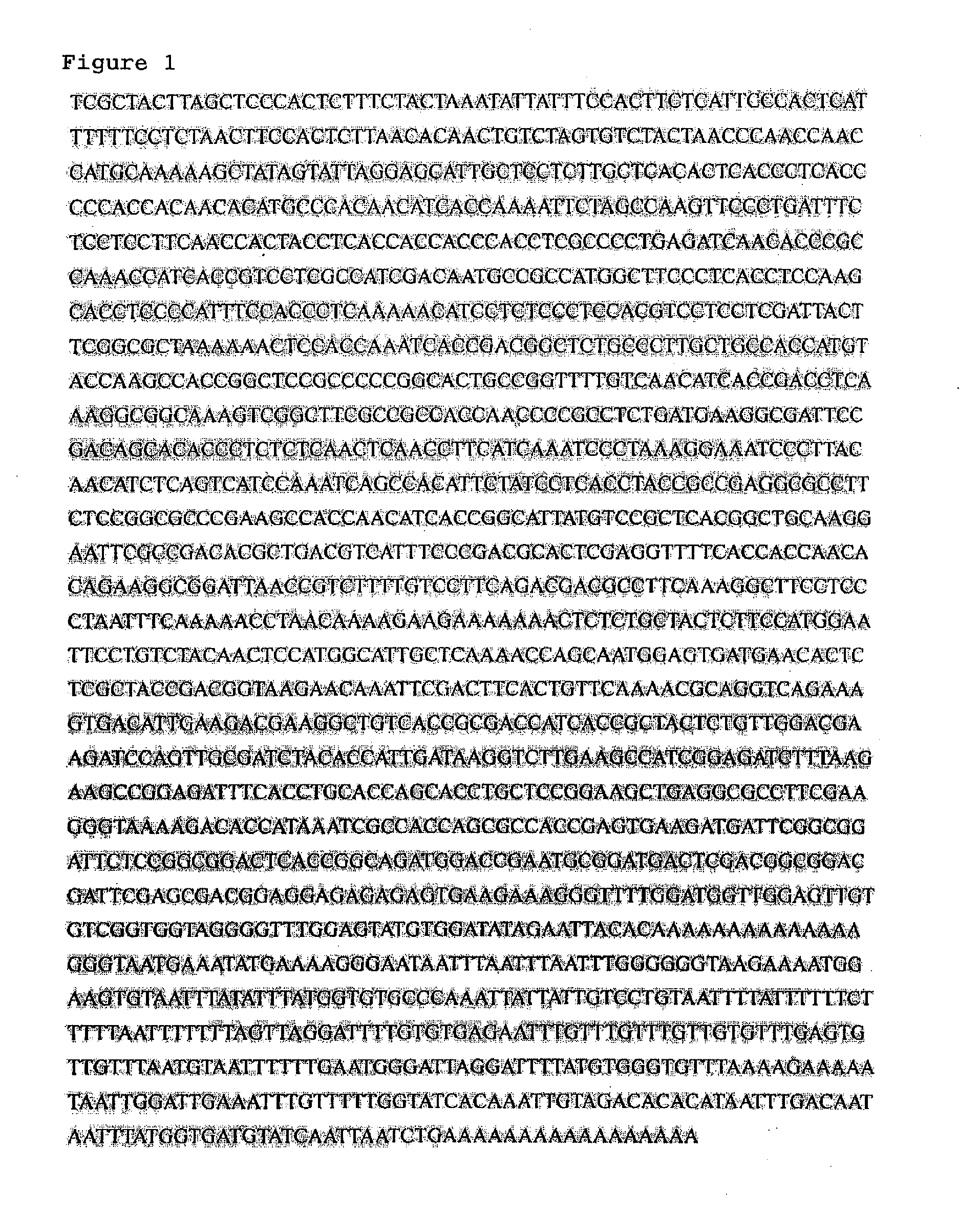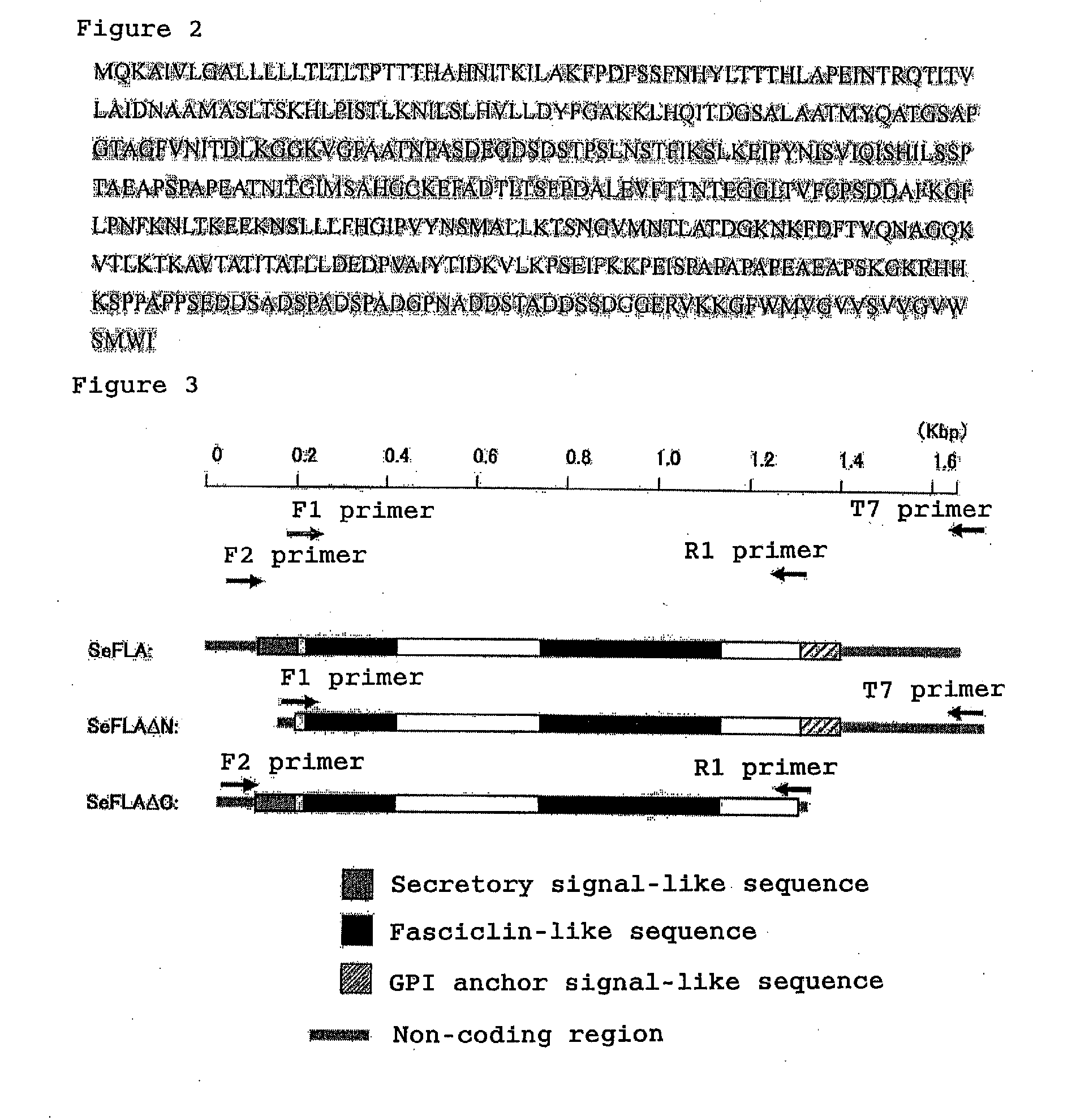Arabinogalactan Protein Having Activity of Improving Tolerance to Heat or Moisture Stress
a technology of arabinogalactan and dna, which is applied in the direction of peptides, plant/algae/fungi/lichens ingredients, plant material, etc., can solve the problems of difficult to stably obtain plant material, difficult to improve salt tolerance of obtained cultured cells, and hardly being found on the salt tolerance gene of i>salicornia europaea /i>, etc., to achieve the effect of improving toleran
- Summary
- Abstract
- Description
- Claims
- Application Information
AI Technical Summary
Benefits of technology
Problems solved by technology
Method used
Image
Examples
example 1
[0052][Preparation of Salicornia europaea cDNA Library]
[0053]Salicornia europaea is an annual herb belonging to the family Chenopodiaceae of the class Dicotyledoneae of the phylum Angiospermae and shows the highest level of salt tolerance (which can grow even at 1 M or higher NaCl concentrations) among higher plants. A Salicornia europaea cDNA library was prepared with the leaves according to procedures shown below. First, total mRNA was extracted according to the method of Ostrem et al. (Plant Physiol Vol. 84 p 1270-1275 (1987)). Poly(A)+RNA was purified from this total mRNA by use of Oligotex-dT30 (Daiichi Pure Chemicals Co., Ltd). cDNA was synthesized on the basis of the purified poly(A)+RNA and introduced into a λZap II (Stratagene) lambda phage vector to construct a cDNA library. A method for constructing a cDNA library by use of λZap II is a well known method, and the actual procedure was performed according to the manual of Stratagene. As a result, the Salicornia europaea cDN...
example 2
[0054][Search for Environmental Stress Tolerance Gene from Salicornia europaea cDNA Library]
[0055]Environmental stress tolerance genes were searched from the Salicornia europaea cDNA library according to a functional screening method using Escherichia coli, which was developed by Yamada et al. (Plant Cell Physiol Vol. 43 p 903-910 (2002)). As a result, improvement in salt tolerance was observed in Escherichia coli in which cDNA of 1765 bp in full length shown in FIG. 1 was introduced. As a result of nucleotide sequence analysis with genetic information processing software (Software Development Co., Ltd.), the nucleotide sequence has been shown to encode a protein consisting of 427 amino acids. The BLAST homology search program was used to perform homology search for the amino acid sequence encoded by the DNA. As a result, the amino acid sequence shown in FIG. 2 was confirmed to have partial homology (58% homology was found in a region at the positions 1 to 427 of the amino acid sequ...
example 3
[0056][Preparation of Partial-length SeFLA cDNA]
[0057]A partial-length sequence (SeFLAΔN) of SeFLA from which the amino acid sequence of the putative secretory signal peptide at the positions 1 to 25 was removed was amplified by PCR using an F1 primer (5′-CCCACCACAACATAAATGCACAACATCACC-3′; SEQ ID NO: 3) and a T7 primer (5′-GTAATACGACTCACTATAGGGC-3′; SEQ ID NO: 4) and using as a template, the full-length SeFLA cDNA (cloned into pBluescript SK) obtained by the above-mentioned screening (FIG. 3). The obtained DNA fragment was blunted with T4 DNA Polymerase and klenow. On the other hand, pBluescript SK, an Escherichia coli expression vector, was cleaved with EcoRV and treated with alkaline phosphatase. Then, the above-mentioned PCR fragment was cloned into the resulting vector. The cloned fragment was confirmed to have no mutation and used in subsequent experiments. Moreover, a partial-length sequence (SeFLAΔC) of SeFLA from which the amino acid sequence of the putative GPI anchor signa...
PUM
| Property | Measurement | Unit |
|---|---|---|
| diameter | aaaaa | aaaaa |
| water stress | aaaaa | aaaaa |
| heat | aaaaa | aaaaa |
Abstract
Description
Claims
Application Information
 Login to View More
Login to View More - R&D
- Intellectual Property
- Life Sciences
- Materials
- Tech Scout
- Unparalleled Data Quality
- Higher Quality Content
- 60% Fewer Hallucinations
Browse by: Latest US Patents, China's latest patents, Technical Efficacy Thesaurus, Application Domain, Technology Topic, Popular Technical Reports.
© 2025 PatSnap. All rights reserved.Legal|Privacy policy|Modern Slavery Act Transparency Statement|Sitemap|About US| Contact US: help@patsnap.com



